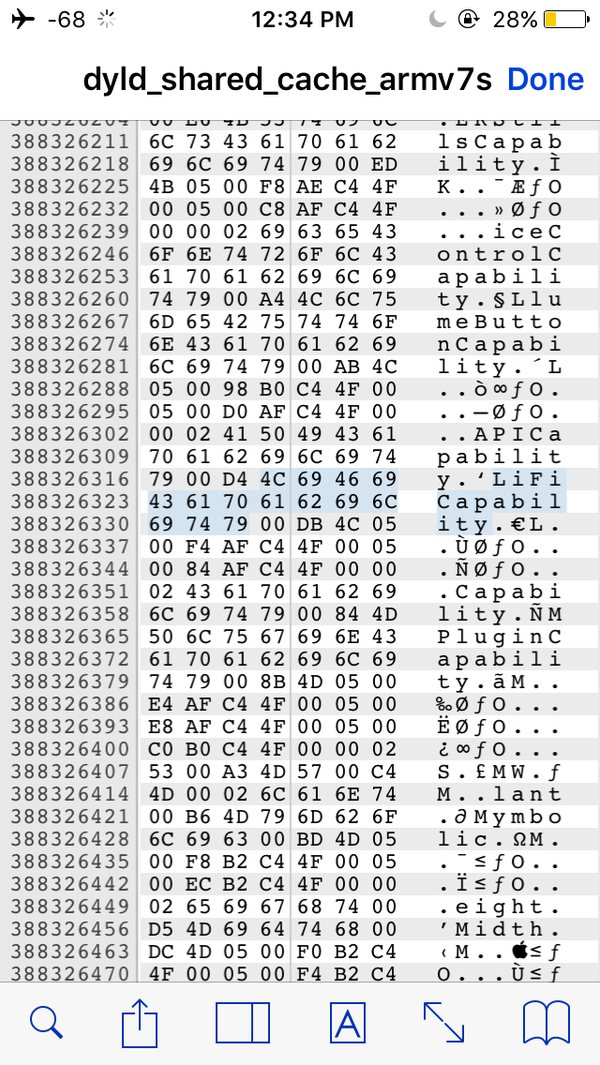Apple Experimenting with Ultra Fast Light-Based Li-Fi Wireless Data for Future iPhones
Recent versions of iOS have been found to contain references to Li-Fi, an experimental high-speed wireless networking protocol that uses pulses of light to transmit data and is being marketed as a long-term replacement for Wi-Fi.
Li-Fi (Light Fidelity) is a bidirectional, high speed and fully networked wireless communication technology similar to Wi-Fi. The term was coined by Harald Haas and is a form of visible light communication and a subset of optical wireless communications (OWC) and could be a complement to RF communication (Wi-Fi or Cellular network), or even a replacement in contexts of data broadcasting. It is so far measured to be about 100 times faster than some Wi-Fi implementations, reaching speeds of 224 gigabits per second.
It is wireless and uses visible light communication or infra-red and near ultraviolet (instead of radio frequency waves) spectrum, part of optical wireless communications technology, which carries much more information, and has been proposed as a solution to the RF-bandwidth limitations.
Before mass adoption of Li-Fi can be realized, either new devices that support the technology need to be released or current devices need to be retrofitted. Li-Fi inventor Professor Harald Haas at the University of Edinburgh has previously claimed that in the future every LED lightbulb could be used as an ultra-fast alternative to Wi-Fi.
“All we need to do is fit a small microchip to every potential illumination device and this would then combine two basic functionalities: illumination and wireless data transmission,” Haas said in a TED talk describing the technology.
“In the future we will not only have 14 billion light bulbs, we may have 14 billion Li-Fis deployed worldwide for a cleaner, greener and even brighter future.”
As Apple relies on wireless technology in favor of thick, dust-collecting ports, the move to headphone jack-less iPhones with Li-Fi speed connectivity doesn’t seem surprising in the least. Wireless transfer 100x that of Wi-Fi would make for an excellent iPhone keynote slide someday.
Standards:
Like Wi-Fi, Li-Fi is wireless and uses similar 802.11 protocols; but it uses visible light communication (instead of radio frequency waves), which has much wider bandwidth.
One part of VLC is modeled after communication protocols established by the IEEE 802 workgroup. However, the IEEE 802.15.7 standard is out-of-date, it fails to consider the latest technological developments in the field of optical wireless communications, specifically with the introduction of optical orthogonal frequency-division multiplexing (O-OFDM) modulation methods which have been optimized for data rates, multiple-access and energy efficiency.[33] The introduction of O-OFDM means that a new drive for standardization of optical wireless communications is required.
Nonetheless, the IEEE 802.15.7 standard defines the physical layer (PHY) and media access control (MAC) layer. The standard is able to deliver enough data rates to transmit audio, video and multimedia services. It takes into account optical transmission mobility, its compatibility with artificial lighting present in infrastructures, and the interference which may be generated by ambient lighting. The MAC layer permits using the link with the other layers as with the TCP/IP protocol.[citation needed]
The standard defines three PHY layers with different rates:
- The PHY I was established for outdoor application and works from 11.67 kbit/s to 267.6 kbit/s.
- The PHY II layer permits reaching data rates from 1.25 Mbit/s to 96 Mbit/s.
- The PHY III is used for many emissions sources with a particular modulation method called color shift keying (CSK). PHY III can deliver rates from 12 Mbit/s to 96 Mbit/s.[34]
The modulation formats recognized for PHY I and PHY II are on-off keying (OOK) and variable pulse position modulation (VPPM). The Manchester coding used for the PHY I and PHY II layers includes the clock inside the transmitted data by representing a logic 0 with an OOK symbol "01" and a logic 1 with an OOK symbol "10", all with a DC component. The DC component avoids light extinction in case of an extended run of logic 0's.[citation needed]
The first VLC smartphone prototype was presented at the Consumer Electronics Show in Las Vegas from January 7–10 in 2014. The phone uses SunPartner's Wysips CONNECT, a technique that converts light waves into usable energy, making the phone capable of receiving and decoding signals without drawing on its battery.[35][36] A clear thin layer of crystal glass can be added to small screens like watches and smartphones that make them solar powered. Smartphones could gain 15% more battery life during a typical day. These first smartphones using this technology should arrive in 2015. This screen can also receive VLC signals as well as the smartphone camera.[37] The cost of these screens per smartphone is between $2 and $3, much cheaper than most new technology.[38]
Philips lighting company has developed a VLC system for shoppers at stores. They have to download an app on their smartphone and then their smartphone works with the LEDs in the store. The LEDs can pinpoint where they are located in the store and give them corresponding coupons and information based on which aisle they are in and what they are looking at.[39]

